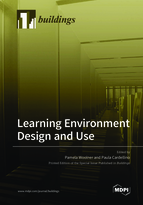Learning Environment Design and Use
A special issue of Buildings (ISSN 2075-5309). This special issue belongs to the section "Building Energy, Physics, Environment, and Systems".
Deadline for manuscript submissions: closed (15 December 2021) | Viewed by 51661
Special Issue Editors
Interests: design, use, and evaluation of educational spaces
Special Issue Information
Dear Colleagues,
Amid burgeoning international interest in the built environment of education, this SI will examine the research, policy, and practice that lies behind the global trends in architecture and pedagogy. We aim to develop an interdisciplinary understanding of the processes and products of school design at all stages, from ‘visioning’ and brief, through habitation and use, to post-occupancy evaluation. The intention is to build knowledge relating to successful design, educational affordances and outcomes, change management, and the alignment of physical resources with teaching and learning needs. We will explore the multiprofessional landscape of educational spaces as they are planned, built, and used, intending to find a shared language to discuss intentions, processes, and outcomes. Reflecting the diversity of the area, the SI editors anticipate empirical work using a wide range of methodologies, transdisciplinary reviews and novel theoretical framings. We are particularly interested in receiving co-authored papers whose authorship bridges academic disciplines, research and practice, or research and policy. The over-arching aim is to capture the diversity of research related to learning environments.
Prof. Dr. Pamela Woolner
Prof. Dr. Paula Cardellino
Guest Editors
Manuscript Submission Information
Manuscripts should be submitted online at www.mdpi.com by registering and logging in to this website. Once you are registered, click here to go to the submission form. Manuscripts can be submitted until the deadline. All submissions that pass pre-check are peer-reviewed. Accepted papers will be published continuously in the journal (as soon as accepted) and will be listed together on the special issue website. Research articles, review articles as well as short communications are invited. For planned papers, a title and short abstract (about 100 words) can be sent to the Editorial Office for announcement on this website.
Submitted manuscripts should not have been published previously, nor be under consideration for publication elsewhere (except conference proceedings papers). All manuscripts are thoroughly refereed through a single-blind peer-review process. A guide for authors and other relevant information for submission of manuscripts is available on the Instructions for Authors page. Buildings is an international peer-reviewed open access monthly journal published by MDPI.
Please visit the Instructions for Authors page before submitting a manuscript. The Article Processing Charge (APC) for publication in this open access journal is 2600 CHF (Swiss Francs). Submitted papers should be well formatted and use good English. Authors may use MDPI's English editing service prior to publication or during author revisions.
Keywords
- Educational facilities
- Infrastructure
- School space
- 21st century learning
- Design process
- Innovative learning environments (ILEs)
- Interdisciplinary
- End-users
- Teaching practices
- Collaboration







